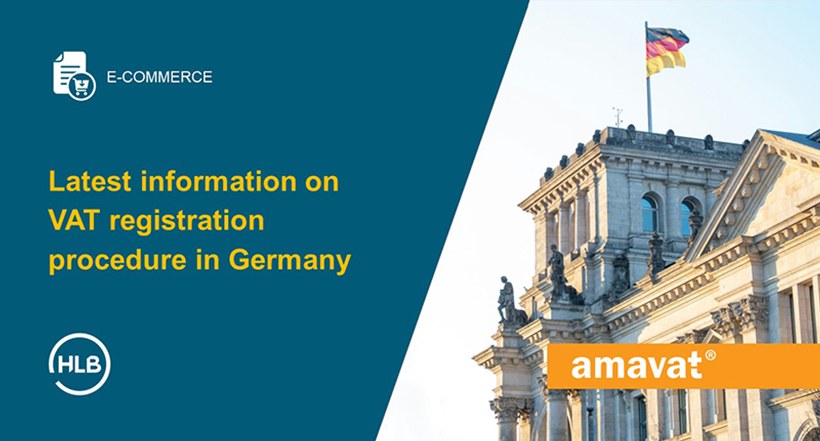Latest information on VAT registration procedure in Germany
Every e-commerce company planning to expand into foreign markets must be aware that this involve fulfilling tax obligations, which can significantly vary depending on the country in which online stores operate or to which they ship their products. What is the current process for VAT registration and tax settlement in Germany? In this article, you will find all the answers!
To begin with, a reminder of some basic information that should be known about VAT in Germany. Value Added Tax (VAT) in Germany is known as Mehrwertsteuer or Umsatzsteuer. The German VAT system is governed by EU directives that apply to all member states of the European Union.
VAT registration requirement in Germany
According to the current regulations, VAT registration in Germany applies to e-commerce entities that:
- Use a warehouse in Germany for shipping goods to customers;
- Conduct online sales directly to German consumers exceeding the limit of 10,000 euros annually (aggregate limit for all EU countries) and do not use VAT OSS procedure;
- Import goods into the German market from outside the European Union or export goods outside the European Union;
- Import goods into the German market from outside the European Union or export goods outside the European Union;
VAT registration in Germany for online sellers – procedure according to 2024 regulations
Online stores can register for VAT in Germany via traditional correspondence. First and foremost, it is necessary to select the German tax office where the e-commerce company will register as a German VAT taxpayer. The choice of the appropriate office in Germany depends on the letter with which the name of the e-commerce entity begins:
- For letters A to G – Tax Office in Hameln;
- For letters H to L – Tax Office in Oranienburg;
- For letters M to R – Tax Office in Cottbus;
- For letters S to Ź – Tax Office in Noerdlingen.
- The websites of each of the above-mentioned offices contain essential information regarding the registration procedure for German VAT. Some information is also provided in Polish.
To become a German VAT taxpayer, the e-commerce company must prepare the necessary documents for VAT registration in Germany. The list of such documents may vary depending on the office or representative to whom the application is submitted. However, it is necessary to prepare for submitting the following documents:
- Articles of association / statutes / company agreement.
- Copy of the excerpt from the National Court Register (KRS) or other relevant register, e.g., CEIDG.
- Current certificate from the Tax Office confirming that the company is an active VAT payer in the EU in Poland.
- Copies of passports or identity cards of shareholders and persons authorized to represent the company.
- Sample invoices issued to recipients in Germany.
- Certificate of Tax Residence Status.
- Consent to contact the Tax Office to obtain the USt-IdNr number.
VAT in Germany – 2024 applicable German VAT numbers and rates
In Germany, there are two VAT numbers.
- Firstly, following a successful registration, e-commerce entities obtain the mandatory Steuernummer (10-11 digits), equivalent to the Polish NIP. It is used for VAT declarations, audits, and daily correspondence with the tax office.
- The second VAT number in Germany is the Umsatzsteuer-Identifikationsnummer (USt-IdNr. – prefix DE followed by 9 digits), equivalent to the EU VAT number. It is voluntary and intended for German taxpayers conducting intra-community transactions within the European Union. This number is visible in the VIES system.
Regarding the USt-IdNr. VAT rates in Germany applicable in 2024:
- 19% – standard rate of German VAT (Umsatzsteuer).
- 7% – reduced VAT rate. Applicable to selected foodstuffs, medical equipment for disabled persons, domestic passenger transport, press materials, books, e-books, audiobooks, participation in cultural and sporting events, short-term accommodation in hotels, and other specified goods and services.
- 0% – zero VAT rate. Mainly applicable to intra-community and international transport, with certain exceptions.
Value Added Tax in Germany – obligation to file VAT returns
In accordance with the regulations applicable in 2024, all e-commerce entities registered in Germany as VAT taxpayers are obliged to submit an annual declaration.
VAT returns are made monthly or quarterly depending on the income. If the income did not exceed 7500 euros in the previous year, declarations can be submitted quarterly; otherwise, they must be submitted monthly.
Not exceeding even 1000 euros (in the previous calendar year) cancels the obligation to submit monthly or quarterly declarations from the new year. The deadline for submitting VAT returns and settling any VAT payments is the 10th day of the month following the end of the settlement period. All VAT returns in Germany are carried out exclusively electronically, using the ELSTER Formular application. More information is available on the website www.elster.de.
Failure to settle or late settlement of German VAT in e-commerce accounting may result in interest or penalties being imposed – from 1% of the required tax to up to 25,000 euros.
VAT in Germany and the VAT OSS procedure
VAT can also be settled in Germany using the special VAT OSS procedure. It allows for the settlement of VAT arising from distance sales throughout the European Union, and it can be used by e-commerce entities from both EU member states and third countries. However, it is important to note that VAT OSS does not apply to B2B sales or local sales.
E-commerce market in Germany – key insights for 2022-2023
- Germany is currently the fourth largest economy in the world.
- The number of e-commerce users in Germany is approximately 70 million.
- Germans spend an average of 2088 euros annually on online shopping, which is the fifth highest in Europe
- Almost 42% of e-consumers in Germany add products to virtual baskets and place orders every week.
- The largest stores and trading platforms in Germany are: Amazon.de, Otto.de, and Zalando.de.
- 15% of the total value of cross-border purchases is generated by Germany.
- The payment market in online stores in Germany is dominated by PayPal. Over 90% of German buyers make payments using it at least once a year.
- In 2022, Germans spent 111 billion euros on online shopping.
- The most popular products in the German e-commerce market are: clothing, electronics, and furniture.
If you are running an e-commerce business and are looking for a comprehensive and unique VAT Compliance service, we invite you to contact our experts: Contact – amavat®.
amavat® Team





